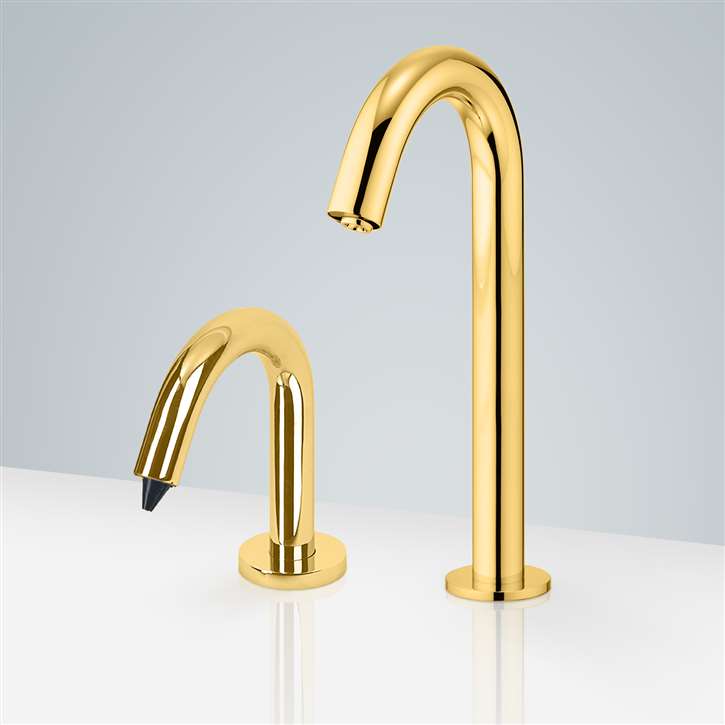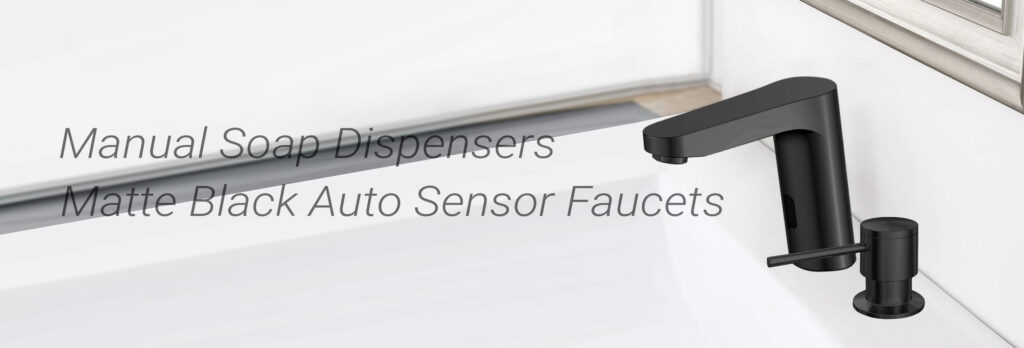Touchless Bathroom Faucets and Touchless Soap Dispensers Trend 2024

In 2024, a new trend for high-traffic restrooms involves not only the integration of touchless bathroom faucets and touchless soap dispensers but also a holistic approach to creating a safe, efficient, and pleasant restroom experience. Here’s a detailed exploration of this emerging trend:
- Comprehensive Touchless System Integration: The trend goes beyond individual touchless fixtures to a comprehensive integration of various touchless systems. This includes touchless bathroom faucets, soap dispensers, hand dryers, and even touchless entry systems for restroom doors. The goal is to minimize touchpoints throughout the entire restroom, reducing the risk of germ transmission in high-traffic areas.
- Smart Restroom Management Systems: High-traffic restrooms benefit from the implementation of smart restroom management systems. These systems use sensors and data analytics to monitor restroom traffic, detect usage patterns, and optimize resource allocation. For example, the system can adjust cleaning schedules, manage consumable refills, and ensure efficient operation of touchless fixtures based on real-time demand.
- Occupancy Monitoring for Crowd Control: To address high traffic, occupancy monitoring systems are integrated into restrooms. Sensors track the number of people in the restroom at any given time, providing insights into peak usage hours. This information can be used to implement crowd control measures, ensuring that the restroom remains accessible, safe, and well-maintained during busy periods.
- Hygiene Stations and UV-C Technology: Beyond touchless fixtures, the trend includes the incorporation of hygiene stations equipped with UV-C technology. These stations can feature touchless hand sanitizers and UV-C sterilization devices for personal items like mobile phones. This adds an extra layer of hygiene and cleanliness, creating a safer environment for restroom users.
- Integrated User Feedback Systems: Restrooms are incorporating touchless user feedback systems to gather real-time insights on cleanliness and user satisfaction. Users can provide feedback using touchless interfaces, enabling restroom management to address issues promptly. This iterative feedback loop ensures continuous improvement in restroom facilities.
- Customizable User Preferences: Touchless systems are becoming more customizable, allowing users to set their preferences for water temperature, soap type, and drying preferences. Personalized touchless interfaces enhance user comfort and contribute to a more user-centric restroom experience, particularly important in high-traffic areas where diverse user preferences exist.
- Energy-Efficient and Eco-Friendly Design: High-traffic restrooms incorporating touchless technology are emphasizing energy efficiency and eco-friendly design. Touchless fixtures are integrated with sensors that optimize water and energy usage. Additionally, sustainable materials and features, such as recycled-content countertops and energy-efficient LED lighting, are being incorporated to align with environmental consciousness.
- Digital Signage and Communication: Touchless digital signage is being used to communicate important information to restroom users. This includes real-time occupancy updates, cleaning schedules, and hygiene reminders. Digital communication reduces the need for physical signage, contributing to a cleaner and more visually appealing restroom environment.
- User Education Initiatives: Restrooms are becoming spaces for user education on proper hygiene practices. Interactive touchless displays provide information on effective handwashing techniques, the importance of hygiene, and updates on the restroom’s cleanliness protocols. This educational aspect enhances user awareness and promotes a culture of cleanliness.
- Aesthetic and Ergonomic Design: Touchless fixtures are integrated into aesthetically pleasing and ergonomic restroom designs. Sleek and modern touchless faucets and dispensers contribute to the overall ambiance of the restroom, creating a more inviting and comfortable space for users.

In summary, the new trend for high-traffic restrooms in 2024 involves a holistic integration of touchless technology, smart management systems, and user-centric features. The focus is on creating a seamless, safe, and efficient restroom experience that addresses the unique challenges posed by high foot traffic while prioritizing hygiene and user satisfaction.
Highlights of Questions and Answers:
Question: What are the emerging trends for touchless bathroom faucets in 2024?
Answer: In 2024, touchless bathroom faucets are trending towards more integrated smart features like temperature memory and usage tracking, which can be controlled via mobile apps for enhanced user customization and water conservation.
Question: How are touchless soap dispensers being designed to match modern bathroom aesthetics in 2024?
Answer: Touchless soap dispensers in 2024 are incorporating minimalist designs with sleek, geometric shapes and matte finishes to blend seamlessly with contemporary bathroom decors.
Question: What technological advancements are being made in touchless faucets and dispensers?
Answer: The latest advancements include improved sensor accuracy for reduced false activations, energy-efficient motors, and the integration of AI to learn user preferences and optimize water and soap usage.
Question: Are there any new features in touchless faucets that enhance user convenience?
Answer: Yes, 2024 sees touchless faucets with features like voice control through smart home assistants, LED temperature indicators, and adjustable settings for flow rate and temperature via touchless gestures.
Question: What sustainability features are being incorporated into touchless bathroom technology?
Answer: Sustainability is a key focus, with features like solar-powered batteries, water flow regulators to minimize waste, and recyclable materials being used in manufacturing touchless faucets and soap dispensers.
Question: How is user experience being prioritized in the design of touchless bathroom fixtures in 2024?
Answer: User experience is enhanced by incorporating ergonomic designs that facilitate ease of use for all ages and abilities, and by ensuring that touchless fixtures work effectively even in low-light conditions.
Question: What are the latest finishes and materials used in touchless faucets and dispensers?
Answer: In 2024, popular finishes include brushed nickel, matte black, and antique bronze, which are chosen for their durability and ease of cleaning. Materials like high-grade stainless steel and corrosion-resistant zinc alloys are preferred for longevity.
Question: How are manufacturers addressing the need for energy efficiency in touchless bathroom fixtures?
Answer: Manufacturers are increasingly using low-power consumption components and offering models that can operate on rechargeable batteries or low-voltage power supplies to reduce energy use.
Question: What role does customization play in the touchless faucet market of 2024?
Answer: Customization is significant, with manufacturers offering a range of customizable options such as adjustable sensor ranges, programmable timers, and modifiable soap dispensing volumes to suit different user preferences and applications.
Question: How are touchless fixtures being marketed to different sectors (residential vs. commercial)?
Answer: For residential markets, the focus is on aesthetics and customization, while for commercial users, the emphasis is on durability, ease of maintenance, and compliance with health standards.
Question: Are there any innovations aimed at reducing installation complexity for touchless fixtures?
Answer: Yes, innovations include modular design elements that allow for easier and faster installations without specialized tools, and wireless technology that reduces the need for extensive plumbing modifications.
Question: How is data from touchless fixtures being used to improve facility management?
Answer: Data collected from smart touchless fixtures is being used to monitor usage patterns, schedule maintenance, and even manage inventory of consumables like soaps and sanitizers, improving overall facility management.

Question: What are the hygiene benefits of the latest touchless bathroom fixtures?
Answer: The primary hygiene benefit is reducing contact points that can harbor bacteria and viruses, significantly lowering the risk of cross-contamination in both residential and public settings.
Question: How do touchless fixtures accommodate users with disabilities?
Answer: Modern touchless fixtures are designed with accessibility in mind, featuring adjustable settings that can be easily used by people with limited mobility or other disabilities.
Question: What are the main challenges facing the adoption of touchless technology in bathrooms?
Answer: Challenges include higher upfront costs compared to traditional fixtures, the need for regular maintenance to ensure sensor accuracy, and user resistance due to unfamiliarity with touchless technology.
Question: How are touchless bathroom technologies contributing to smarter homes and buildings?
Answer: They integrate with other smart home systems for centralized control and monitoring, contributing to the overall intelligence of building management systems by providing data-driven insights.
Question: What are consumers’ main concerns about touchless faucets and how are manufacturers addressing them?
Answer: Consumers are primarily concerned about reliability and maintenance. Manufacturers are addressing these concerns by improving sensor technology, offering extended warranties, and providing better customer support.
Question: Are touchless fixtures becoming more affordable in 2024?
Answer: Yes, as the technology becomes more widespread and production scales up, the costs of touchless fixtures are decreasing, making them more accessible to a broader market.
Question: How is the public reception of touchless bathroom technologies changing in 2024?
Answer: Public reception is increasingly positive, especially as awareness of the hygiene and sustainability benefits grows, and as people become more accustomed to touchless technology in various settings.
Question: What future developments can we expect in the field of touchless bathroom technology?
Answer: Future developments are likely to include even greater integration with IoT for real-time health monitoring, more refined sensor technology, and further enhancements in energy efficiency and user interactivity.
